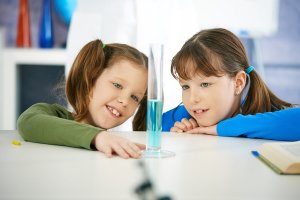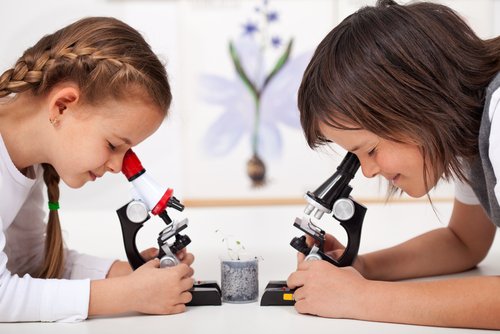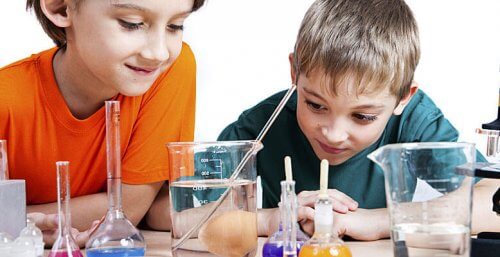4 Experiments You Can Do at Home with Children

These fun experiments you can do at home with children are easy, simple, and economic because you usually already have all the necessary materials. They’re a great way to spend time together as a family and enjoy exploring the physical laws of the universe.
4 fun experiments you can do at home with children
Children have lots of fun when they experience new things, so rest assured that they’ll love these activities.
1. Liquid rainbow
This experiment is very eye-catching and fun for children. To avoid accidents, it’s essential that guidance is provided by parents or other responsible adults.
Materials: 1 glass jar, alcohol, honey, green liquid soap, dishwasher, olive oil, food coloring, and 1 dropper.
Instructions: pour the honey into the glass jar directly to the bottom without touching the sides. Then add liquid soap as well. Separately, mix water with purple or blue food coloring and pour it over the liquid soap.
Next, add a thick layer of olive oil, always in the center without touching the sides of the jar. Finally, dilute red food coloring in alcohol, put it in a dropper, and let it drain inside the jar. You must be careful not to drop it in the center like the previous ones because it’ll ruin the rainbow.
The scientific explanation of this experiment is simple: the density of the different liquids is what produces the rainbow. The densest liquids stay at the bottom due to their weight, while the lightest remain on the surface. Additionally, the liquids don’t mix with each other because they have different densities.

2. Eggs that float and sink in water
These experiments you can do at home with your children are fascinating. To children, they can seem like magic, although they have a rational explanation.
Materials: 2 eggs, water, salt, and 2 containers.
Instructions: Place an egg in each container filled with water and allow children to observe what happens next. You’ll see that one of the eggs sinks and the other one stays afloat.
They’ll think that the eggs are different. Subsequently, exchange the eggs in the containers. The same thing will happen, the egg that was previously afloat is now sinking and the other one is now floating.
The scientific explanation is that one of the containers has water with salt, which modifies the density of the water. Under normal conditions, the egg weighs more than water.
However, if enough salt is added to the water, its density becomes greater than the egg’s, so the egg floats.
You can also perform this experiment by placing an egg in a container of water and adding salt gradually. You’ll see how the egg slowly rises, to the point of floating on the surface.
“The cure for boredom is curiosity. There is no cure for curiosity.”
–Dorothy Parker–
3. Dancing worms
Materials: jelly worms, water, vinegar, baking soda, and a transparent glass cup.
Instructions: cut the worm into four pieces lengthwise. Then, place it in a glass of warm water with three tablespoons of baking soda for 15 minutes.
After that, remove them from the glass with a fork and place them in a glass with vinegar. The worms immediately fill up with bubbles and rise to the surface.
When the gas bubbles burst, the worms go back to the bottom where they fill up with bubbles once more and rise again. This process repeats itself several times until one of the reagents is spent; either the bicarbonate or the vinegar.
The rationalization of this experiment is that when you take worms that are full of sodium bicarbonate and mix them with vinegar, a chemical reaction occurs that produces gas bubbles.
That means carbon dioxide surrounds the jelly worms. This causes the ascending and descending movement, which gives the impression that the worms dance.

4. Separating pepper from water
These experiments you can do at home stimulate children’s learning during free time and also help strengthen family ties. This one, which only requires common kitchen ingredients, is a great example.
Materials: 1 deep dish, soap, black pepper, and water.
Instructions: pour enough water in a deep dish and sprinkle just a little black pepper on it. When you insert your finger in the water, the pepper doesn’t move. However, if you put soap on your finger and insert it in the water again, you’ll see how the pepper moves away from the center of the dish.
The reason is that pepper floats on the surface of the water, where there is a layer of firmer water called surface tension. Nonetheless, when filled with soap, this surface tension decreases in the center, which allows the pepper to move away.
In conclusion, experiments you can do at home with children offer many benefits, besides being easy and entertaining. Practicing them will help your child develop an interest in science.
These fun experiments you can do at home with children are easy, simple, and economic because you usually already have all the necessary materials. They’re a great way to spend time together as a family and enjoy exploring the physical laws of the universe.
4 fun experiments you can do at home with children
Children have lots of fun when they experience new things, so rest assured that they’ll love these activities.
1. Liquid rainbow
This experiment is very eye-catching and fun for children. To avoid accidents, it’s essential that guidance is provided by parents or other responsible adults.
Materials: 1 glass jar, alcohol, honey, green liquid soap, dishwasher, olive oil, food coloring, and 1 dropper.
Instructions: pour the honey into the glass jar directly to the bottom without touching the sides. Then add liquid soap as well. Separately, mix water with purple or blue food coloring and pour it over the liquid soap.
Next, add a thick layer of olive oil, always in the center without touching the sides of the jar. Finally, dilute red food coloring in alcohol, put it in a dropper, and let it drain inside the jar. You must be careful not to drop it in the center like the previous ones because it’ll ruin the rainbow.
The scientific explanation of this experiment is simple: the density of the different liquids is what produces the rainbow. The densest liquids stay at the bottom due to their weight, while the lightest remain on the surface. Additionally, the liquids don’t mix with each other because they have different densities.

2. Eggs that float and sink in water
These experiments you can do at home with your children are fascinating. To children, they can seem like magic, although they have a rational explanation.
Materials: 2 eggs, water, salt, and 2 containers.
Instructions: Place an egg in each container filled with water and allow children to observe what happens next. You’ll see that one of the eggs sinks and the other one stays afloat.
They’ll think that the eggs are different. Subsequently, exchange the eggs in the containers. The same thing will happen, the egg that was previously afloat is now sinking and the other one is now floating.
The scientific explanation is that one of the containers has water with salt, which modifies the density of the water. Under normal conditions, the egg weighs more than water.
However, if enough salt is added to the water, its density becomes greater than the egg’s, so the egg floats.
You can also perform this experiment by placing an egg in a container of water and adding salt gradually. You’ll see how the egg slowly rises, to the point of floating on the surface.
“The cure for boredom is curiosity. There is no cure for curiosity.”
–Dorothy Parker–
3. Dancing worms
Materials: jelly worms, water, vinegar, baking soda, and a transparent glass cup.
Instructions: cut the worm into four pieces lengthwise. Then, place it in a glass of warm water with three tablespoons of baking soda for 15 minutes.
After that, remove them from the glass with a fork and place them in a glass with vinegar. The worms immediately fill up with bubbles and rise to the surface.
When the gas bubbles burst, the worms go back to the bottom where they fill up with bubbles once more and rise again. This process repeats itself several times until one of the reagents is spent; either the bicarbonate or the vinegar.
The rationalization of this experiment is that when you take worms that are full of sodium bicarbonate and mix them with vinegar, a chemical reaction occurs that produces gas bubbles.
That means carbon dioxide surrounds the jelly worms. This causes the ascending and descending movement, which gives the impression that the worms dance.

4. Separating pepper from water
These experiments you can do at home stimulate children’s learning during free time and also help strengthen family ties. This one, which only requires common kitchen ingredients, is a great example.
Materials: 1 deep dish, soap, black pepper, and water.
Instructions: pour enough water in a deep dish and sprinkle just a little black pepper on it. When you insert your finger in the water, the pepper doesn’t move. However, if you put soap on your finger and insert it in the water again, you’ll see how the pepper moves away from the center of the dish.
The reason is that pepper floats on the surface of the water, where there is a layer of firmer water called surface tension. Nonetheless, when filled with soap, this surface tension decreases in the center, which allows the pepper to move away.
In conclusion, experiments you can do at home with children offer many benefits, besides being easy and entertaining. Practicing them will help your child develop an interest in science.
All cited sources were thoroughly reviewed by our team to ensure their quality, reliability, currency, and validity. The bibliography of this article was considered reliable and of academic or scientific accuracy.
- Lowenfeld, V. (1987). Desarrollo de la capacidad creadora. Ed. Kapelusz. Argentina: Buenos aires.
- Madi, I. (2012). La creatividad y el Niño. Palibrio. Estados Unidos.
- Navarro Lozano, J. (2009). Mejora de la creatividad en el aula de primaria. Proyecto de investigación. https://digitum.um.es/digitum/handle/10201/3049
- Vargas, R. R. (2001). Niños creativos.
- Wallon, P., Cambier, A. y Engelhart, D. (1992). El dibujo del niño. Siglo XXI editores. España: Madrid.
This text is provided for informational purposes only and does not replace consultation with a professional. If in doubt, consult your specialist.








